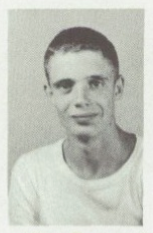After sixteen years in the West, Thomas Lovewell came back to Illinois to find that his wife and father had died during his long absence and his two daughters had been given away to be raised by strangers, their current whereabouts a mystery. While visiting his sister at Keokuk, Iowa, he ran into his dead wife’s sister, Orel Jane Moore, a young widow who was then teaching school. Orel Jane had divorced her first husband, Alfred Moore, who died shortly afterward in the Civil War. After being married by her brother Daniel, a minister, Orel Jane and Thomas decided to come to Kansas along with several members of her family. She gave her son, whom she had named Emery Perry Moore, to be reared by her parents at Clyde, while she and Thomas journeyed farther west to settle in the White Rock valley.
It was after reading what was essentially the family story paraphrased above, distilled from pages 66 and 67 of “The Lovewell Family,” that I began reconstructing the life of Thomas Lovewell to fit the facts as I had come to know them. By the way, I’ve deliberately arranged each sentence of the preceding paragraph so that even if one happens to contain a grain of truth, it comes paired with a glaring falsehood. For instance, while there’s no getting around the fact that the families really did come to Kansas together, Orel Jane actually named her boy Vinson Perry Moore and gave him to Sylvester and Diantha Haynes at Clifton (Although he wound up spending some of his boyhood at Grandma Julana's house anyway). A man from Texas, Emery Perry Moore, the son of a Kansan named Perry Moore, Sr., may have tried to pass himself off as Orel Jane’s son to sponge some money from her.
I should stress that, aside from Emery Moore, no one tried to pull the wool over anyone’s eyes. The story as it’s been told since about 1933 was woven out of bits of oral history glued together with assumptions that just seemed to make sense. By the way, as far as I can tell, no one in the family lived at Keokuk in 1865. The place name occurs because of the misspelling of a word in 1920, a misreading of the misspelling in the 1950’s, and a misunderstanding about what word was misspelled in the first place. The cascade of errors has left Keokuk stuck to the family story like a wad of chewing gum on the bottom of someone’s shoe. I’ve tried to scrape it off, but I’m sure there’ll be sticky residue for years to come.
What I’ve been writing about regularly for nearly a year now, involves how history comes to be written, how typos (Including some that I’ve made) become embedded in text, how pictures are misidentified or misdated, and how much of what we thought we knew, turns out to be a mistake that’s been repeated for so long that it’s become grandfathered in. My last posting was about an old picture which I thought might be at odds with its own caption. It seems to me that, depending on which clues we consider most important, there’s about an 18-month window when it might have been taken. The age of one granddaughter in the picture and the absence of another one could be helpful clues. Dave Lovewell emailed a suggestion I hadn’t noticed: “What’s that in Ben Stofer’s left hand? Could it be an apple he had just picked?” I have a feeling that Dave is basically picking on me, but it could indeed be an apple. Or perhaps Ben was playing pool and walked outside with the cue ball in his hand. Was Ben left-handed? If he was, it’s an apple. If he was right-handed it’s probably a cue ball. See? Writing about history takes some deep thinking.
For what it’s worth, I think it is an apple. Violet Lovewell isn’t in the photo because she hadn’t finished her Christmas shopping, and may have been stocking up on winter apparel at bargain prices, because unseasonably warm December weather had left clothing stores overstocked. Little Freida Lovewell was ten months old, and the date the photo was taken is December 20, 1913, when, the newspapers would later say, several of Thomas Lovewell’s children dropped by to wish him a happy birthday.

Dave also informed me that Max Lovewell passed away this week. I’ve tried to find out if he might have been a Maxwell or a Maximillian, but he appears to have been just “Max,” the son of Cecil and Nora (McGraw) Lovewell and grandson of Stephen and Alta Lovewell. Dave remembers him as a mellow man who never seemed to age, looking the same at seventy as he had at seventeen, making it seem appropriate to post his high school yearbook photograph. He died a few weeks short of what would have been his eightieth birthday.
I’m always curious about the thought process parents go through when naming their children, and the Lovewell family always provides me with plenty of room for speculation. “Max” was not a rare name when Cecil’s youngest boy was born, but it was uncommon enough that the census-taker in 1940 wrote it as “Macks.” For many of us, it's associated with Lovewell history because of Max Bixby, who wrote a series of articles in the 1960’s for the Superior Express about settlements along the White Rock. Bixby would have been nearly forty when Max Lovewell was born, and lived in Hardy at the time. It’s also possible that Cecil named his boy as a tip of the ten-gallon hat to Frederick Schiller Faust, who turned out pulp Westerns by the yard in the 20’s and 30’s under the pen name Max Brand, among others. Come to think of it, Max Lovewell would have made a great name for a Western hero.